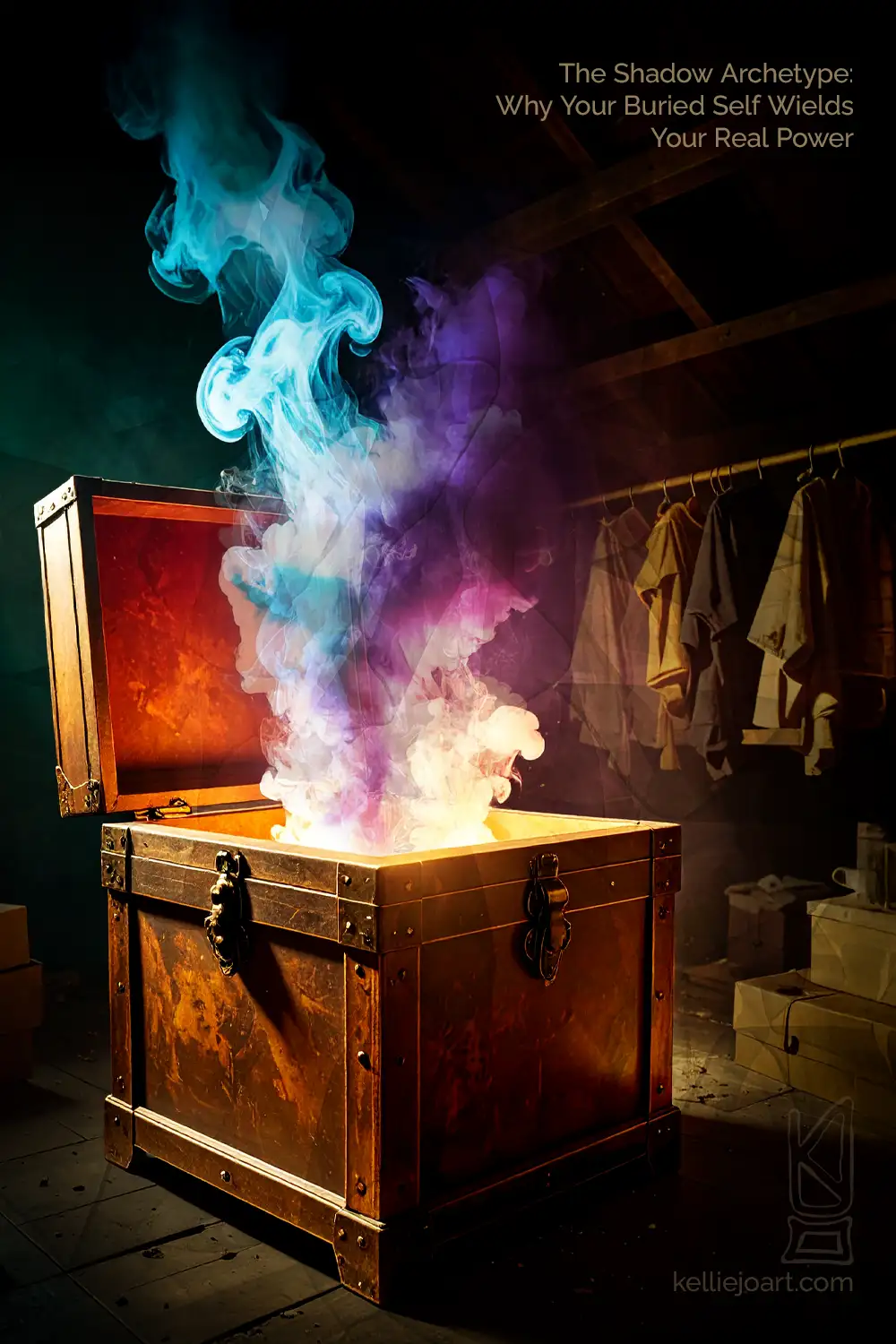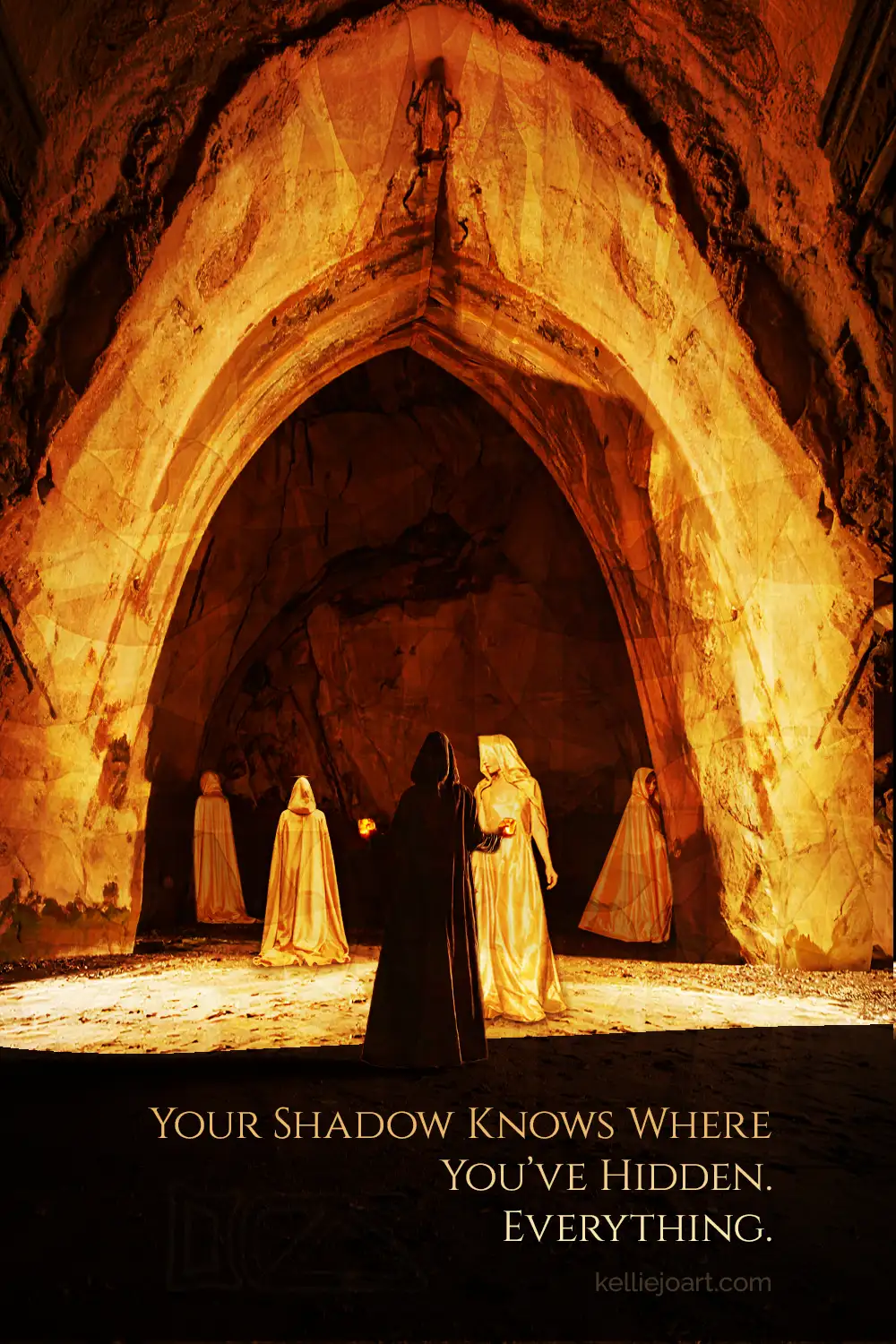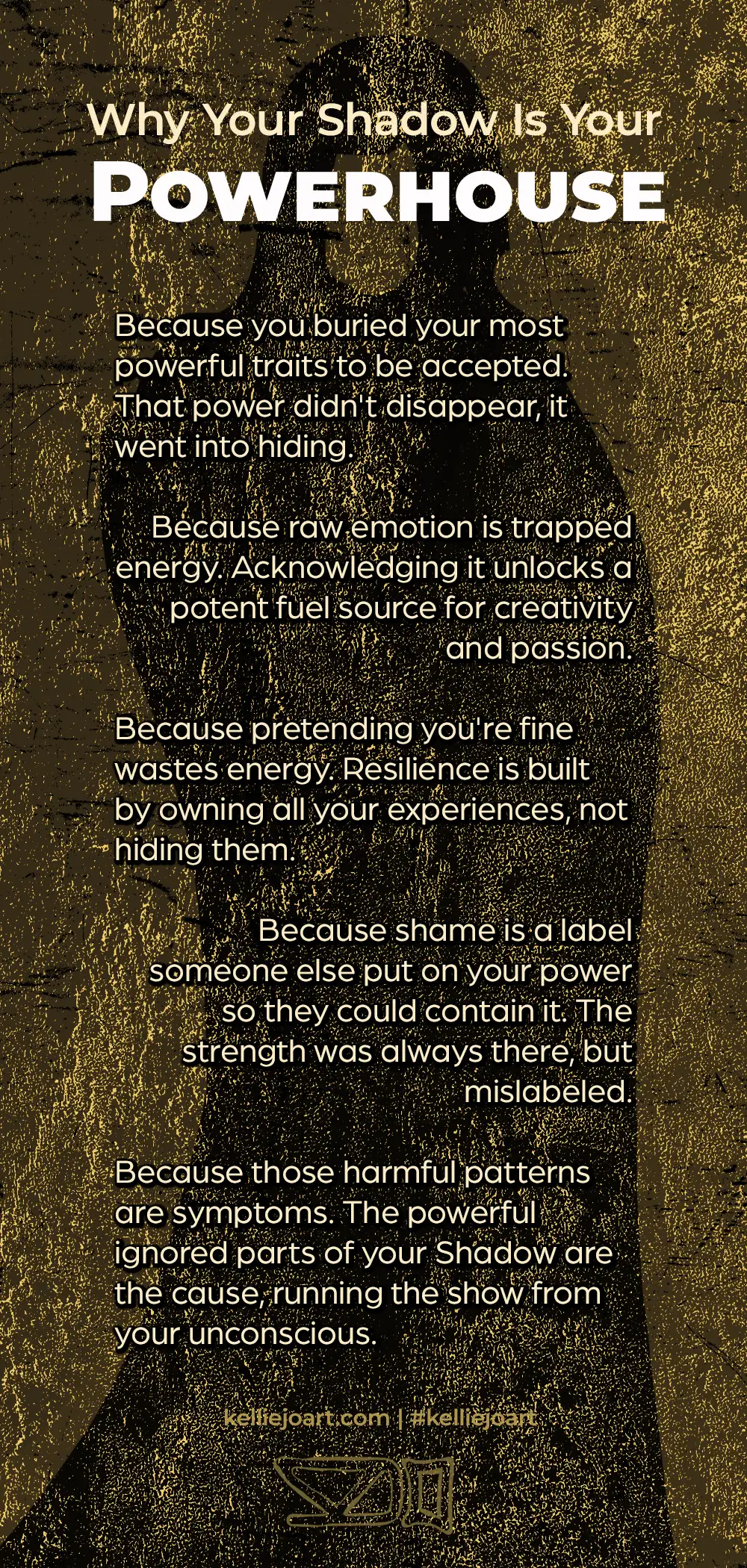Index

The Shadow isn’t the part of you that’s broken—it’s the part you buried because it wasn’t safe to show. It’s the collection of traits, desires, and memories you learned to hide to survive. Think of it as your personal Pandora’s box, stuffed with everything you deemed unacceptable, messy, or inconvenient. It’s the powerfully protective side of your psyche that holds your fears and forbidden desires, taking notes and waiting patiently while you pretend it isn’t there.
We all have one. Swiss psychiatrist Carl Jung, who first coined the term, believed the shadow archetype was a fundamental part of the human psyche. The shadow archetype serves as a vault for these repressed traits, shaping our personalities in ways we rarely realize. It’s the unconscious repository for everything we reject about ourselves. The parts you were told were “too much,” “not enough,” “too loud,” or “too sensitive.”
You pushed them down, not because they were inherently bad, but because you were taught they were. And now, those buried bits of you run the show from under your radar, influencing your choices, triggering your emotions, and keeping you stuck in patterns you can’t seem to break.
But here’s the truth they don’t tell you in feel-good wellness culture: confronting the shadow archetype isn’t about fixing your flaws. It’s about reclaiming your power.
What Exactly Is the Shadow Archetype?
The shadow archetype is the sum of all the parts of yourself you’ve disowned. Society, family, and your own inner critic deemed some traits unacceptable, so you shoved them into the dark. This includes the obvious stuff we perceive as negative, like rage, jealousy, and selfishness. But it’s much more than a garbage bin for your vices.
Your Shadow also contains your gold. It holds your suppressed strengths, untapped creativity, raw ambition, and powerful intuition—qualities that may have been dismissed, shamed, or seen as a threat by others. Maybe you learned to quiet your ambition because it made people uncomfortable. Maybe you buried your artistic talent because you were told it wasn’t a practical way to make a living.
Jung argued that avoiding this part of yourself doesn’t make it go away; it only strengthens its hold over you. The more you suppress, the more it seeps out sideways. This is the core of the shadow archetype: an ignored force that shapes your reality whether you acknowledge it or not.
How the Shadow Runs Your Life from the Backseat
If you pretend your Shadow isn’t there, it doesn’t just sit quietly in the corner. It directs your life in ways you don’t consciously understand. The shadow archetype operates behind the scenes, influencing your behaviors, relationships, and emotional responses. Unacknowledged Shadows show up as destructive patterns, emotional triggers, and a persistent feeling of being disconnected from yourself.
Here’s what that looks like in the real world:
- Emotional Triggers: That disproportionate rage you feel when someone dismisses your opinion? That’s often the Shadow projecting what it cannot accept onto others. Your intense reaction is a signpost pointing to a part of you that feels unseen or invalidated—a part you’ve buried.
- Harmful Patterns: The same toxic relationship dynamic showing up with a different person? The career self-sabotage that kicks in right when you’re about to succeed? These repeating cycles are often the unconscious trying to get your attention, replaying a wound until you finally turn around and face it.
- Projection: We tend to despise the traits in others that we refuse to acknowledge in ourselves. If you’re constantly irritated by someone’s arrogance, there might be a part of your own confidence you’ve suppressed. If you can’t stand someone’s vulnerability, you’re likely looking at a reflection of a softness in yourself you’ve judged as weak. The Shadow uses other people as a mirror for what you won’t look at in yourself.
- Feeling Numb or Disconnected: When you systematically suppress so-called “negative” emotions like anger and grief, you don’t just numb the pain—you numb everything else, too. Joy, passion, and creativity get buried right alongside the darkness, leaving you feeling detached from your own life.
For years, I lived with the conditioned belief that happiness wasn’t safe. A fleeting moment of joy would be followed by a spike of anxiety, bracing for the inevitable crash. That was my Shadow, conditioned by trauma to associate joy with danger. It wasn’t until I recognized that pattern that I could begin to reclaim my right to feel good without waiting for the other shoe to drop.
Ignore The Shadow, and she’ll run the show from the backseat. Confront her, and you’ll find out just how powerful you can become.
The Art of Confidence
The Art of Confidence: A Guide to Trusting Yourself on Life’s Creative Battlefield (PDF)
Step onto life’s creative battlefield armed with self-belief. This gritty, psychologically-rich guide helps you start trusting yourself and unleashing your creative power—without waiting to feel “ready.”
There’s more to see here.Or Buy the paperback on Amazon for $3 dollars more.
The Golden Shadow: Reclaiming the Power You Disowned

The most transformative part of this work is realizing the shadow archetype isn’t just a monster in the closet. Understanding the shadow archetype in its entirety means recognizing both its darkness and its brilliance. It can be a treasure chest. Jungian analyst Robert Johnson coined the term “Golden Shadow” to describe the positive, powerful, and brilliant parts of ourselves that we also suppress.
Why would we hide our best qualities? We often do it for the same reasons we hide our flaws: fear of rejection, fear of visibility, or fear of failure. We disown our strengths because they threaten the status quo or make others uncomfortable.
You can find clues to your Golden Shadow by paying attention to who you admire or envy. That person you’re intensely jealous of for their unapologetic confidence? That confidence likely exists within you, waiting to be claimed. The artist whose creative freedom you admire from afar? That’s a mirror of your own untapped potential.
Ask yourself:
- What qualities do I deeply admire in others?
- What compliments do I brush off because they don’t feel true?
- What did I love to do as a child before someone told me it was silly or worthless?
The answers point directly to the gold you’ve buried. Reclaiming your Golden Shadow is about recognizing that the strengths you project onto others already exist within you. They are not ideals to strive for; they are parts of yourself waiting to be remembered.
Meeting Your Shadow Archetype (Without Getting Obliterated)
Let’s be honest: facing your Shadow can feel like stepping into the ring with a heavyweight champion who knows all your weak spots. It’s messy and confrontational. There’s no sugarcoating it. But you don’t have to dive into the deep end all at once. The first step is simply to turn on the light and be willing to look.
Here are a few tools to start the conversation:
- Observe Your Triggers Without Judgment. The next time you have an intense emotional reaction, don’t just react. Get curious. Ask yourself: What’s really underneath this anger? What old wound does this remind me of? Your triggers are messengers from your unconscious. Stop shooting the messenger and start reading the mail.
- Give Your Shadow a Voice. Art bypasses the rational mind and allows the unconscious to speak directly. You don’t need to be an artist. Try this simple exercise: Take a piece of paper write the words, “What do you need me to know?” Then, use your non-dominant hand to answer without thinking or censoring. The result might be messy or nonsensical at first, but it’s a direct line to a part of you that doesn’t usually get to speak.
- Track Your Dreams. Jung considered dreams a direct line to the unconscious. Keep a journal by your bed and write down everything you remember upon waking—symbols, feelings, characters—no matter how strange. Look for recurring themes. Are you always being chased? Are you in a house you don’t recognize? These are symbolic messages from your Shadow, offering clues about what you’re avoiding or what needs to be reclaimed in your waking life.
The point of these practices isn’t to get a perfect answer. The point is to show up and listen. That willingness alone begins to shift the power dynamic. Embracing the shadow archetype isn’t about perfection—it’s about permission. Permission to be fully human.
Integration: Becoming Dangerously Whole
The goal of shadow work isn’t to eliminate the shadow archetype. That’s impossible and, frankly, undesirable. The goal is integration. Integration means you bring the Shadow into awareness, acknowledge its presence, and give it a place in the whole of who you are instead of letting it run the show from the dark.
I learned this firsthand. For years, I carried the silent truth of an abusive marriage. One day, I tried to draw how I felt, and what emerged shocked me. I had drawn my own naked body, ripped in two at the waist. My first instinct was to hide it, to shove that horrifying truth back down. But I knew that was no longer an option. The image haunted me, demanding to be seen. I kept working on the drawing, engaging with the pain to figure out what it needed. The answer was clear: it needed a coffin. That pain wanted to die, and to give it what it needed, I had to leave.

That act of creation didn’t erase the trauma. It transformed my relationship to it. It allowed me to take ownership of my story and decide how to carry it forward. That is integration. It’s the moment you stop fighting the parts of you that feel like burdens and start seeing them as sources of strength. You learn that the anger that once felt destructive is actually a fierce protector. The sensitivity you saw as a weakness is actually a source of profound empathy and intuition.
Integrating the shadow archetype makes you whole. It makes you dangerous—in the best way possible. You stop playing small. You show up with an untouchable strength because you are no longer afraid of what’s inside you.
Your Shadow Is Not Your Enemy
The shadow archetype is not a flaw to be fixed. It is a fundamental, powerful, and vital part of you. It holds the energy, creativity, and authenticity you’ve been searching for. It’s where your deepest resilience is forged. Confronting it is an act of radical self-acceptance. It’s choosing to meet yourself fully, without rejecting what is difficult to see.
The question isn’t whether you have a Shadow. It’s whether you’re ready to stop letting it drive from the backseat and finally take the wheel. The work is hard, but the reward is real. It’s the freedom that comes from owning every last piece of yourself.
Go Exploring: The art is for your hands, your altar, your shelf—wherever you need to hold something heavy. The blog is where the hard truths go to get named. And the Shadow Seekers’ Dispatch shows up once a month with tools, stories, and things that might make you flinch. No fake urgency. Just real work you can return to when you’re ready.


Leave a Reply